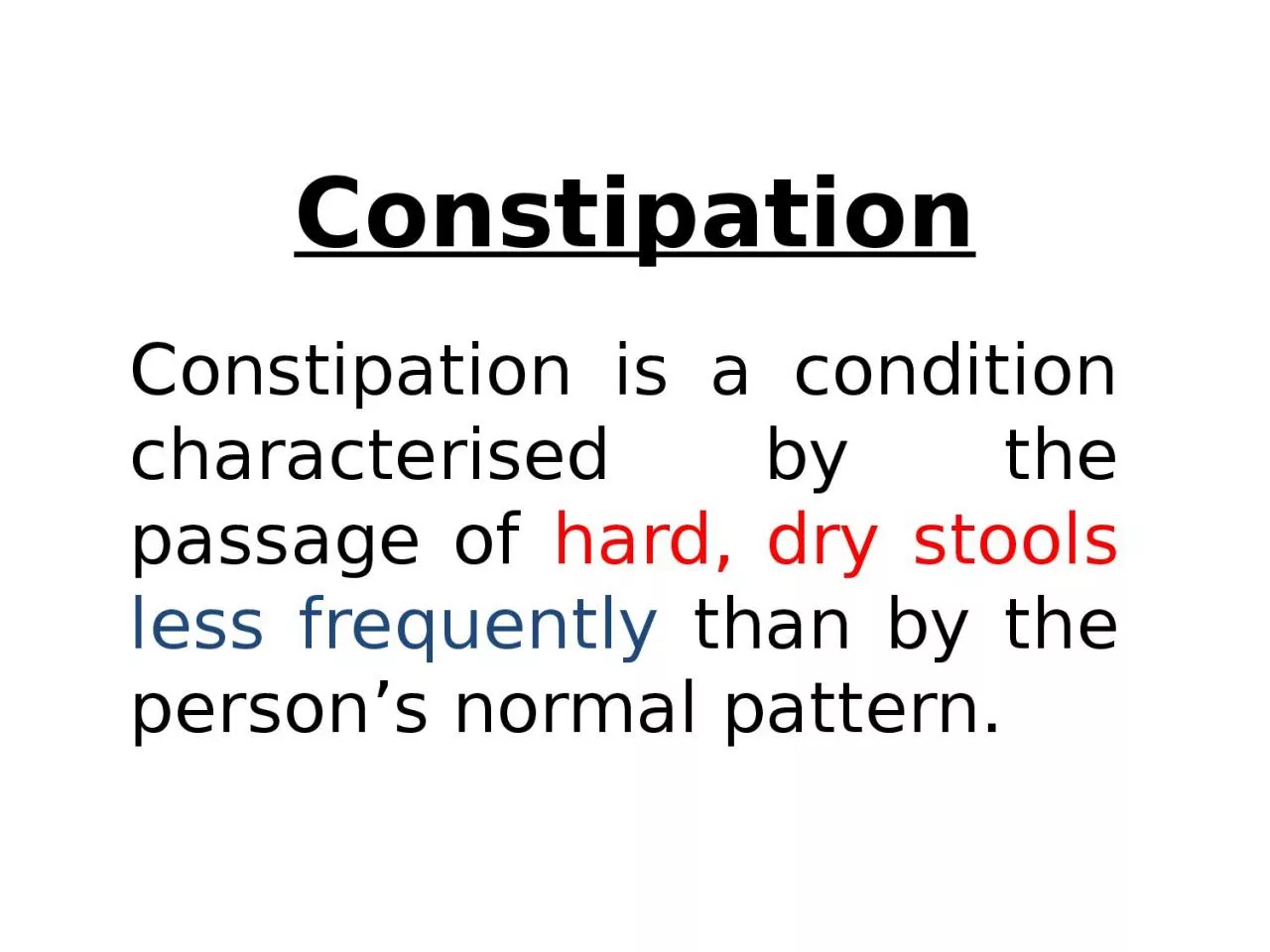

characterised by the passage of hard dry stools less frequently than by the persons normal pattern Patient Assessment Details of bowel habit Associated symptoms Bowel cancer ID: 934830
Download Presentation The PPT/PDF document "Constipation Constipation is a condition" is the property of its rightful owner. Permission is granted to download and print the materials on this web site for personal, non-commercial use only, and to display it on your personal computer provided you do not modify the materials and that you retain all copyright notices contained in the materials. By downloading content from our website, you accept the terms of this agreement.
Slide1
Constipation
Constipation is a condition
characterised
by the passage of
hard, dry stools
less frequently
than by the person’s normal pattern.
Slide2Patient Assessment
Details of bowel habit
Associated
symptoms….
Bowel cancer
Diet and lifestyle
Medication
(laxative abuse, drugs can induce constipation)
Slide3Associated symptoms
Abdominal discomfort
,
bloating
and
nausea Mild CaseColicky abdominal pain, abdominal distension Severe Case and vomiting (obstruction) Blood in the stool Haemorrhoid or anal fissure
Slide4drugs can induce constipation
Analgesics and opiates (
Dihydrocodeine
, codeine),
Antacids (
Aluminium salts), Anticholinergics (Hyoscine),Anticonvulsants (Phenytoin), Antidepressants (Tricyclics, selective serotonin reuptake inhibitors)Antihistamines (Chlorpheniramine, promethazine), Antihypertensives (Clonidine, methyldopa),Anti-Parkinson agents (Levodopa), Iron,
Laxative abuse.
Slide5When to refer
Change in bowel habit of 2 weeks or longer
Presence of abdominal pain, vomiting, bloating
Blood in stools
Prescribed medication suspected of causing symptoms
Failure of OTC medication
Slide6Treatment timescale
A-If the pharmacist gives
non-pharmacologic
advice only, then the treatment timescale is
2 weeks.B-If the pharmacist gives laxative drug, then the treatment timescale is 1week only.
Slide7Management
Non-pharmacologic advices:
1. Increasing the amount of dietary fiber,
2. Maintaining fluid consumption,
3. Doing regular exercise.
Slide8Pharmacological Treatment
The drug selection should be based on:
Patients characteristics (age, pregnancy…),
Patient preference,
How quickly
an effect is needed, Side effects,Cost.
Slide9Type of laxative
Example(s) Approximate onset of action
1-Stimulant laxative
(
Senna
, Bisacodyl, Sodium, picosulfate, and Glycerin (supp.)Oral: 6-12 hoursRectal: within 1 hour2-Bulk-forming laxative Methylcellulose, Bran , Sterculia and Ispaghula (Metamucil®)12 -24 hours, but onset may be delayed as long as 72 hours
3-Lubricant (faecal softeners)
Liquid paraffin6-8 hours
4-Osmotic laxative
Lactulose
1-2 days
Slide10Patient Preferred Laxative
Pregnant women
Bulk-forming laxative.
Lactulose
Breast-feeding mother
Bulk-forming laxative, LactuloseChildrenGlycerin(supp.), Lactulose
Advanced age (elderly
)
Bulk-forming laxative, Also
Lactulose
and
Glycerin
(supp.)
Slide11Special cases
Constipation in pregnancy
Constipation in the elderly
Constipation in children
Laxative abuse
Slide12When to refer
Laxative Abuse In Chronic Constipation
Slide13Diarrhoea
Diarrhoea
is defined as an
increased frequency
of bowel evacuation, with the passage of abnormally
soft or watery faeces.
Slide14Patient assessment
Age
Duration
Severity
Symptoms
Recent travel abroad
Slide15Causes of Acute
Diarrhoea
< 14 days
Viral
Bacterial
Protozoan
Slide16Causes of Chronic Diarrhoea
> 4 weeks
Irritable Bowel,
Bowel
Tumour
, Inflammation of The Bowel (Ulcerative Colitis or Crohn’s Disease), An Inability to Digest or Absorb Food (Malabsorption, Coeliac Disease) or Diverticular Disease of The Colon.
Slide17Medication
Medicines already
tried
…The pharmacist should establish the identity of any medication that has already been taken to treat the symptoms in order to assess its appropriateness.
Other medicines being
taken…Details of any other medication being taken (both OTC and prescribed) are also needed, as the diarrhoea may be drug induced.
Slide18Some Drugs that
may cause
Diarrhea:
Antacids:
Magnesium salts
AntibioticsAntihypertensives: methyldopa; beta-blockers (rare)Digoxin (toxic levels)Diuretics (furosemide)Iron preparationsLaxativesMisoprostolNon-steroidal anti-inflammatory drugsSelective serotonin reuptake inhibitors
Slide19When to refer
Diarrhoea
of greater than
1
day’s duration in children younger than 1 year
2 days’ duration in children under 3 years and elderly patients3 days’ duration in older children and adultsAssociation with severe vomiting and feverRecent travel abroadSuspected drug-induced reaction to prescribed medicinePresence of blood or mucus in the stoolsPregnancy
Slide20Symptoms of Dehydrations
Children
Dry mouth, tongue and skin
Fewer or no tears when crying
Decreased urination (less than 4 wet diapers in 24 hours)
Sunken eye, cheeks or abdomenSunken fontanelDecreased skin turgorIrritability or listlessnessAdultsIncreased thirstDecreased urinationFeeling weak or lightheadedDry mouth/ tongue
Slide21Management
Oral rehydration
therapy (ORT),
1day
in children
; 2 days in others Amount of ORT to be offered: Quantity of solutionAge (per watery stool)Under 1 year 50 mL (quarter of a glass)1–5 years 100
mL (half a glass)
6–12 years 200
mL
(
one glass)
Adult
400
mL
(
two glasses
)
Slide22Antimotility
Drugs
Loperamide
Diphenoxylate
/atropine (Co-phenotrope)MorphineAdsorbentsKaolin
Slide23Irritable Bowel Syndrome (IBS)
IBS is
chronic
, functional bowel disorder in which abdominal pain is associated with intermittent
diarrhoea
, sometimes alternating with constipation, and a feeling of abdominal distension.the condition appears to be higher in women.It often seems to be triggered by stress, and many IBS sufferers have symptoms of anxiety and depression. Some sufferers have food intolerances which trigger their symptoms.
Slide24Patient Assessment
Age
Symptoms (
Abdominal pain, Bloating, Bowel habit)
Other symptoms (
Nausea; vomiting, backache, lethargic and tired, Urinary symptoms like frequency, urgency and nocturia).PeriodicityPrevious historyAggravating factorsMedication
Slide25When to refer
Children
Older person with no previous history of IBS
Pregnant women
Blood in stools
Unexplained weight lossCaution in patients aged over 45 years with changed bowel habitSigns of bowel obstructionUnresponsive to appropriate treat
Slide26Treatment
timescale
Symptoms should start to improve within
1 week
.
Slide27Management
A-Diet
B-Antispasmodics
Mebeverine
hydrochloride
Alverine citratePeppermint oilHyoscine butyl bromideC-Laxative and Antidiarrheals